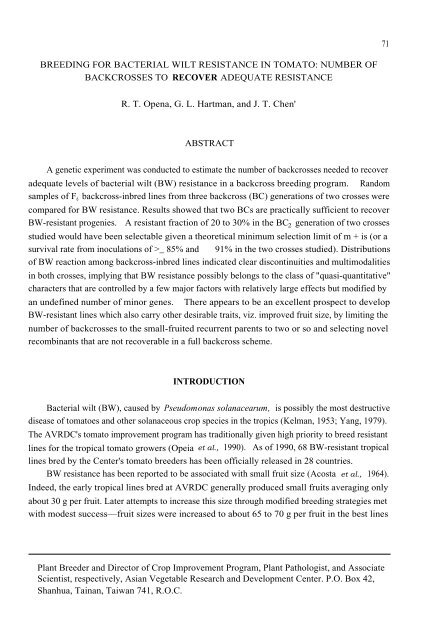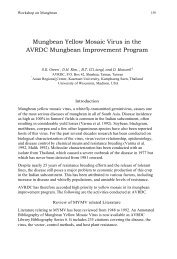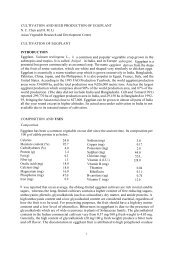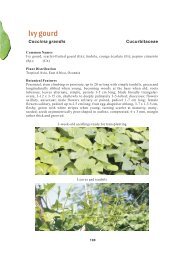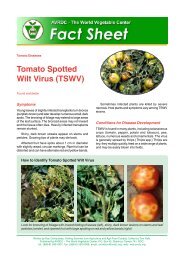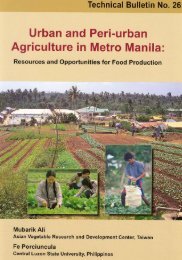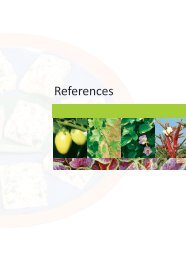71 BREEDING FOR BACTERIAL WILT RESISTANCE IN TOMATO ...
71 BREEDING FOR BACTERIAL WILT RESISTANCE IN TOMATO ...
71 BREEDING FOR BACTERIAL WILT RESISTANCE IN TOMATO ...
Create successful ePaper yourself
Turn your PDF publications into a flip-book with our unique Google optimized e-Paper software.
<strong>BREED<strong>IN</strong>G</strong> <strong>FOR</strong> <strong>BACTERIAL</strong> <strong>WILT</strong> <strong>RESISTANCE</strong> <strong>IN</strong> <strong>TOMATO</strong>: NUMBER OF<br />
BACKCROSSES TO RECOVER ADEQUATE <strong>RESISTANCE</strong><br />
R. T. Opena, G. L. Hartman, and J. T. Chen'<br />
ABSTRACT<br />
A genetic experiment was conducted to estimate the number of backcrosses needed to recover<br />
adequate levels of bacterial wilt (BW) resistance in a backcross breeding program. Random<br />
samples of F 6 backcross-inbred lines from three backcross (BC) generations of two crosses were<br />
compared for BW resistance. Results showed that two BCs are practically sufficient to recover<br />
BW-resistant progenies. A resistant fraction of 20 to 30% in the BC 2 generation of two crosses<br />
studied would have been selectable given a theoretical minimum selection limit of m + is (or a<br />
survival rate from inoculations of >_ 85% and 91% in the two crosses studied). Distributions<br />
of BW reaction among backcross-inbred lines indicated clear discontinuities and multimodalities<br />
in both crosses, implying that BW resistance possibly belongs to the class of "quasi-quantitative"<br />
characters that are controlled by a few major factors with relatively large effects but modified by<br />
an undefined number of minor genes. There appears to be an excellent prospect to develop<br />
BW-resistant lines which also carry other desirable traits, viz. improved fruit size, by limiting the<br />
number of backcrosses to the small-fruited recurrent parents to two or so and selecting novel<br />
recombinants that are not recoverable in a full backcross scheme.<br />
<strong>IN</strong>TRODUCTION<br />
Bacterial wilt (BW), caused by Pseudomonas solanacearum, is possibly the most destructive<br />
disease of tomatoes and other solanaceous crop species in the tropics (Kelman, 1953; Yang, 1979).<br />
The AVRDC's tomato improvement program has traditionally given high priority to breed resistant<br />
lines for the tropical tomato growers (Opeia et al., 1990). As of 1990, 68 BW-resistant tropical<br />
lines bred by the Center's tomato breeders has been officially released in 28 countries.<br />
BW resistance has been reported to be associated with small fruit size (Acosta et al., 1964).<br />
Indeed, the early tropical lines bred at AVRDC generally produced small fruits averaging only<br />
about 30 g per fruit. Later attempts to increase this size through modified breeding strategies met<br />
with modest success—fruit sizes were increased to about 65 to 70 g per fruit in the best lines<br />
Plant Breeder and Director of Crop Improvement Program, Plant Pathologist, and Associate<br />
Scientist, respectively, Asian Vegetable Research and Development Center. P.O. Box 42,<br />
Shanhua, Tainan, Taiwan 741, R.O.C.<br />
<strong>71</strong>
72<br />
(Opera, 1985; Opera et al., 1987). However, conspicuous loss of resistance did occur in many<br />
lines when selection for large fruit size was intensely practiced.<br />
Tropical lines continue to be improved in a number of characters with progressive breeding<br />
(Opera et al., 1990). Pyramiding these traits into a single genotype at the highest possible<br />
intensity of expression, particularly complex traits like BW resistance, necessitates the use of<br />
backcross breeding technique. However, the typical tropical lines that would normally serve as<br />
recurrent parents in such backcross programs are generally small-fruited and need to be improved<br />
for a number of other traits. Thus, it is not desirable to fully reconstitute their genetic<br />
backgrounds into the new backcross derivatives. Ideally, the backcrosses should be as few as<br />
possible to enable the selection of novel gene combinations, e.g., improved fruit size and BW<br />
resistance.<br />
The present study was conducted to estimate the minimum number of backcrosses that could<br />
be adopted as a guideline in breeding tomatoes for the tropics and to gain an insight on the<br />
behavior of the bacterial wilt resistance genes in the populations studied.<br />
MATERIALS AND METHODS<br />
Random F 6 lines (referred to below as "backcross-inbred" lines) of three backcross<br />
generations (BC 1 , BC2 and BC3) of two crosses with one common parent (CLN690 and CLN735)<br />
were developed for this study. CLN690 came from the cross of BW-resistant tropical line<br />
CL5915-93 with BL284 (cv. Cavalier, a large fruited, BW-susceptible variety from Peto Seed<br />
Company), whereas CLN735 was derived from the cross of tropical line CLN65-349 with BL284.<br />
The tropical stocks in both cases served as the recurrent parents.<br />
The experimental materials were sown on August 19, 1991 in 6-cm diameter plastic pots.<br />
A split-split plot arrangement of factors in a randomized complete block design with two<br />
replications was followed. The three backcross generations served as subplots; whereas, the two<br />
cross combinations served as main plots. Twenty backcross-inbred lines of each backcross family,<br />
along with four check cultivars, comprised 24 sub-subplots. The checks were as follows: resistant<br />
and susceptible parents; resistant check, L285; susceptible check, L390. Individual plots<br />
comprised 24 seedlings.<br />
Each seedling was inoculated with 20 ml bacterial suspension at an inoculum density of 10 8<br />
bacterial cells per ml on September 19. The inoculated seedlings were kept inside a warm plastic<br />
house (30°C mean temperature) afterwards. Weekly wilt readings were made from September<br />
26 to October 17. Individual survival rate data (%) of the unit plots were transformed into arcsin<br />
x V . % to normalize the data scale prior to statistical analysis.
RESULTS AND DISCUSSION<br />
Table 1 presents the BW reaction of the backcross populations and generations. As may be<br />
noted, the parents were st r ikingly well-contrasted to expect marked segregation among their<br />
backcross-inbred progenies.<br />
Table 1. Bacterial wilt reaction of random F 6 backcross-inbred lines averaged over the backcross<br />
populations and generations; AVRDC, 1991 summer.<br />
Family Survival rate (%) §<br />
Backcross population<br />
CLN 690 64.1 a<br />
CLN 735 64.6 a<br />
Backcross generation<br />
BC, 59.6 b<br />
BC 2<br />
BC3<br />
Resistant and susceptible parents<br />
66.6 a<br />
66.8 a<br />
Resistant parent of CLN 690 79.1<br />
Susceptible parent of CLN 690 4.9<br />
Resistant parent of CLN735 87.2<br />
Susceptible parent of CLN735 1.4<br />
§ Mean separation by Duncan's Multiple Range Test at P = 0.05. (Note: values for parents are<br />
included only for numeric comparison)<br />
The BW resistance levels of the two crosses were statistically similar. On the other hand,<br />
the resistance level increased as expected with successive backcrosses to the resistant parents.<br />
However, the increase from BC2 to BC 3 was insignificant. It appears that making a third<br />
backcross does not offer any real advantage in so far as enhancing the general population mean<br />
for BW resistance is concerned.<br />
The comparative statistics from frequency distribution analyses of the BC populations for each<br />
cross are given in Table 2. Cross CLN690 showed a dramatic increase in its level of resistance<br />
from BC 1 to BC2 but followed by a slight though insignificant decrease in BC3. The expected<br />
dissipation of variability with progressive backcrosses was apparent. It appears that most of the<br />
important BW resistance genes of the recurrent parent in CLN690 had already been captured by<br />
the second backcross.<br />
In cont r ast to CLN690, CLN735 started off with already a high level of BW resistance in<br />
BC, followed by small changes in further backcrosses. Variability was surprisingly unchanged<br />
73
74<br />
from backcross to backcross and can be explained if the recurrent parent itself is heterozygous for<br />
the trait. However, our available data on the parent, CLN65-349, a breeding line that has<br />
undergone more than 10 generations of selling, does not support this view. It is more plausible<br />
to assume that the important genes for BW resistance in this cross were already captured in only<br />
one backcross and that the variability and selection advance observed in the subsequent<br />
backcrosses likely arose from the action of minor genes.<br />
Table 2. Comparative statistics for bacterial wilt resistance of F 6 backcross-inbred lines from two<br />
populations; AVRDC, 1991 summer.<br />
Cross Generation Mean survival<br />
rate (%)<br />
Standard<br />
Deviation<br />
Selectable §<br />
progenies (%)<br />
CLN 690 BC 1 55.4 16.9 25<br />
BC2 77.5 6.5 30<br />
BC3 72.3 7.3 25<br />
CLN 735 BC 1 <strong>71</strong>.4 11.3 15<br />
BC 2 65.8 11.3 20<br />
BC 3 70.8 13.4 25<br />
§ Selection limit theoretically set at minimum of (m + 1 s) or higher for purposes of comparison, corresponding to<br />
minima of 85% and 91% survival rate for CLN 690 and CLN 735, respectively.<br />
If it is assumed that only progenies whose BW reading are equal to or greater than m + is<br />
are to be selected, a selectable fraction of 30% is already attainable in CLN690 by BC2<br />
generation. In contrast, there is a steady increase in selectable proportions with progressive<br />
backcrossing in CLN735. In the BC 2, this fraction is already 20% of the population, a figure that<br />
may be considered already workable in the breeding program. It appears that two backcrosses<br />
may indeed be sufficient to recover good levels of BW resistance in the backcross program.<br />
The frequency histograms for BW readings of BCF 6 lines from the three backcross<br />
generations of CLN690 are shown in Fig. 1. Multimodality and discontinuity of distribution are<br />
evident in all generations. Such behavior often points to traits that are "quasi-quantitative" in<br />
nature, i.e., controlled by several genetic factors with relatively major effects on the trait but<br />
whose expressions are altered by an undefined number of minor genes or modifiers.<br />
A similar trend was present in CLN735 although distinct fractions of the susceptible classes<br />
which are markedly set apart from the upper "resistant" fraction remained after three backcrosses.<br />
The high level of BW resistance in this cross after only one backcross to the recurrent parent<br />
seems to indicate that most, if not all, the major genes controlling BW resistance could have<br />
already been captured at that stage and that the residual genetic variation observed in subsequent<br />
backcrosses are background effects of modifier genes.
Fig. 1. Frequency histograms of BW resistance among random F6 backcross-inbred lines from<br />
population CLN690.<br />
26<br />
53<br />
45<br />
BC1<br />
BC3<br />
mean = 55.4<br />
standard dev = 16.9<br />
mean = 72.3<br />
standard dev = 7.3<br />
BW survival rate (aresin ')<br />
SUMMARY AND CONCLUSION<br />
A genetic experiment was conducted to estimate the number of backcrosses needed to recover<br />
adequate levels of bacterial wilt (BW) resistance in a backcross (BC) breeding program. Random<br />
samples of F6 backcross-inbred lines from three BC generations of two crosses were compared<br />
for BW resistance. Results showed that two BCs are practically sufficient to recover BW-resistant<br />
70<br />
75<br />
69<br />
75
76<br />
progenies. A resistant fraction of 20 to 30 % in the BC2 generation of the two crosses studied<br />
would have been selectable given a theoretical minimum selection limit of m -- Is (or a survival<br />
rate from BW inoculations of >_ 85% and 91% in the two crosses studied). Distributions of<br />
BW reaction among backcross-inbred lines indicated clear discontinuities and multimodalities in<br />
both crosses, implying that BW resistance possibly belongs to the class of "quasi-quantitative"<br />
characters that are controlled by a few major factors with relatively large effects on the trait but<br />
whose expressions are modified by minor genes. Based from the results, there appears to be an<br />
excellent prospect to develop BW-resistant lines which also carry other desirable traits, viz.<br />
improved fruit size, by limiting the number of backcrosses to the small-fruited recurrent tropical<br />
lines to about two and selecting novel gene combinations that could not be recovered, otherwise,<br />
in a full backcross program.<br />
REFERENCES<br />
Acosta, J. C., J. C. Gilbert, and V. L. Quinon. 1964. Heritability of bacterial wilt resistance in<br />
tomato. Proc. Am. Soc. Hort. Sci. 84: 455-461.<br />
Kelman, A. 1953. The bacterial wilt caused by Pseuclomonas solanacearum. Raleigh, North<br />
Carolina. North Carolina Agricultural Experiment Station. Bull. 99: 194p.<br />
Opera, R. T. 1985. Development of tomato and Chinese cabbage cultivars adapted to the hot,<br />
humid tropics. Acta Hort. 153: 421-436.<br />
Opera, R. T., G. C. Kuo and J. Y. Yoon. 1987. Breeding for stress tolerance under tropical<br />
conditions in tomato and heading Chinese cabbage. Improved Vegetable Production in<br />
Asia. Taipei, Taiwan, ASPAC-FFTC. 88-109.<br />
Opeiia, R. T., S. K. Green, N. S. Talekar and J. T. Chen. 1990. Genetic improvement of<br />
tomato adaptability to the tropics. Integrated Pest and Management Practices for Tomato<br />
and Pepper in the Tropics, Tainan, Taiwan, Asian Vegetable Research and Development<br />
Center. 70-85.<br />
Opeiia, R. T., G. L. Hartman, J. T. Chen and C. H. Yang. 1990. Breeding for bacterial wilt<br />
resistance in tropical tomato. 3rd International Conference on Plant Protection in the<br />
Tropics, Genting Highlands, Malaysia. (in press).<br />
Yang, C. Y. 1979. Bacterial and fungal diseases of tomato. Proc. 1st International Symposium<br />
on Tropical Tomato, Shanhua, Taiwan, Asian Vegetable Research and Development<br />
Center. 111-123.


